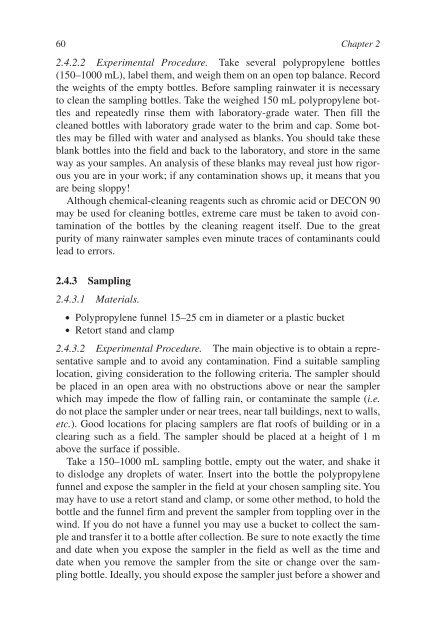Chapter 2 Rainwater Analysis (Phân tích nước mưa) - Practical Environmental Analysis, 2nd Edition - M. Radojevic, V. Bashkin
https://app.box.com/s/xse2wn3eson14p2iefjpryednq896xhy
https://app.box.com/s/xse2wn3eson14p2iefjpryednq896xhy
Create successful ePaper yourself
Turn your PDF publications into a flip-book with our unique Google optimized e-Paper software.
60 <strong>Chapter</strong> 2<br />
2.4.2.2 Experimental Procedure. Take several polypropylene bottles<br />
(150–1000 mL), label them, and weigh them on an open top balance. Record<br />
the weights of the empty bottles. Before sampling rainwater it is necessary<br />
to clean the sampling bottles. Take the weighed 150 mL polypropylene bottles<br />
and repeatedly rinse them with laboratory-grade water. Then fill the<br />
cleaned bottles with laboratory grade water to the brim and cap. Some bottles<br />
may be filled with water and analysed as blanks. You should take these<br />
blank bottles into the field and back to the laboratory, and store in the same<br />
way as your samples. An analysis of these blanks may reveal just how rigorous<br />
you are in your work; if any contamination shows up, it means that you<br />
are being sloppy!<br />
Although chemical-cleaning reagents such as chromic acid or DECON 90<br />
may be used for cleaning bottles, extreme care must be taken to avoid contamination<br />
of the bottles by the cleaning reagent itself. Due to the great<br />
purity of many rainwater samples even minute traces of contaminants could<br />
lead to errors.<br />
2.4.3 Sampling<br />
2.4.3.1 Materials.<br />
● Polypropylene funnel 15–25 cm in diameter or a plastic bucket<br />
● Retort stand and clamp<br />
2.4.3.2 Experimental Procedure. The main objective is to obtain a representative<br />
sample and to avoid any contamination. Find a suitable sampling<br />
location, giving consideration to the following criteria. The sampler should<br />
be placed in an open area with no obstructions above or near the sampler<br />
which may impede the flow of falling rain, or contaminate the sample (i.e.<br />
do not place the sampler under or near trees, near tall buildings, next to walls,<br />
etc.). Good locations for placing samplers are flat roofs of building or in a<br />
clearing such as a field. The sampler should be placed at a height of 1 m<br />
above the surface if possible.<br />
Take a 150–1000 mL sampling bottle, empty out the water, and shake it<br />
to dislodge any droplets of water. Insert into the bottle the polypropylene<br />
funnel and expose the sampler in the field at your chosen sampling site. You<br />
may have to use a retort stand and clamp, or some other method, to hold the<br />
bottle and the funnel firm and prevent the sampler from toppling over in the<br />
wind. If you do not have a funnel you may use a bucket to collect the sample<br />
and transfer it to a bottle after collection. Be sure to note exactly the time<br />
and date when you expose the sampler in the field as well as the time and<br />
date when you remove the sampler from the site or change over the sampling<br />
bottle. Ideally, you should expose the sampler just before a shower and


















